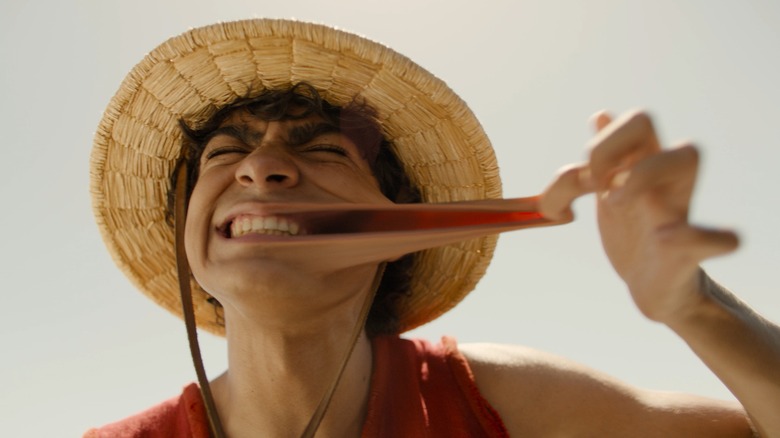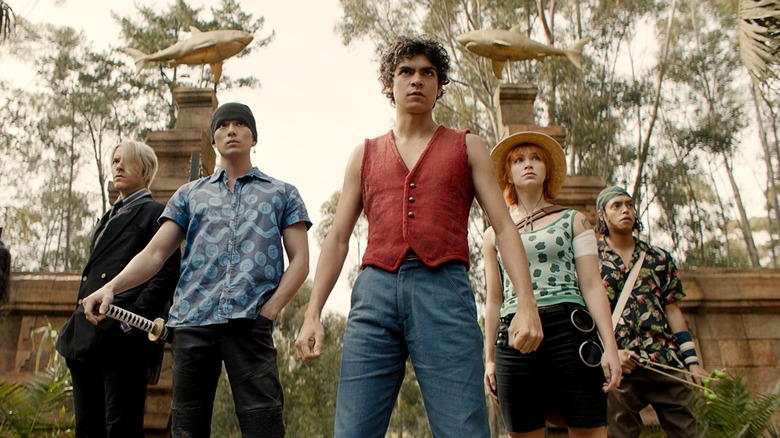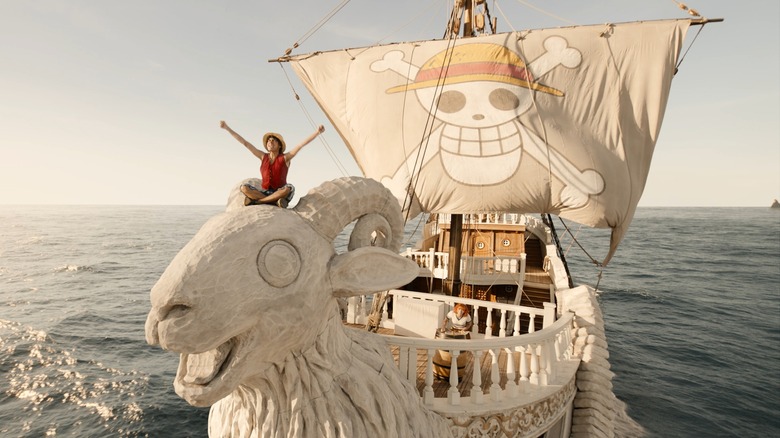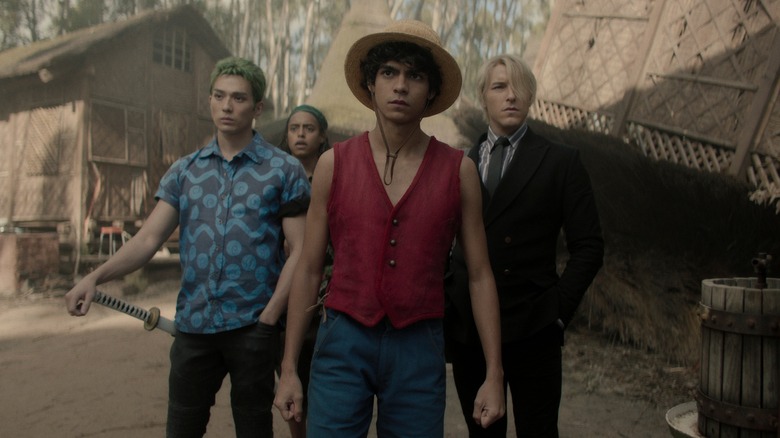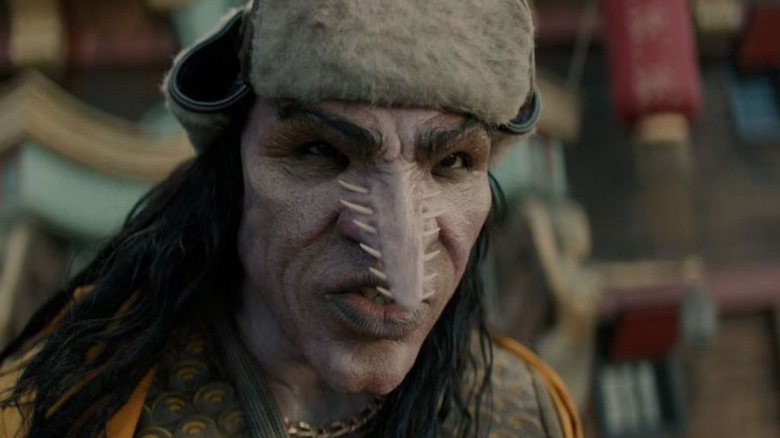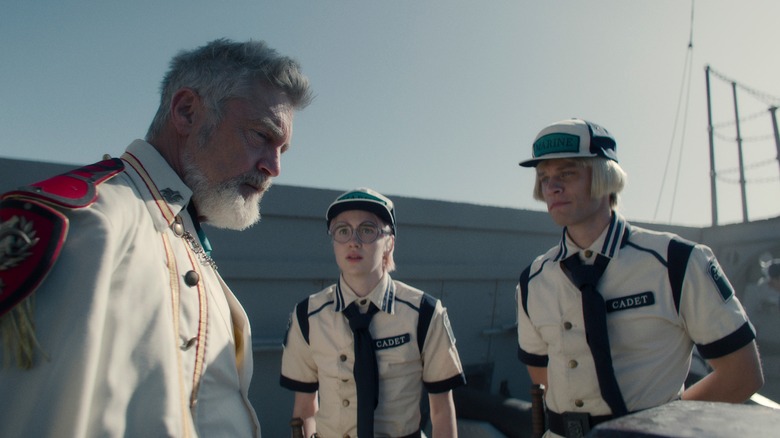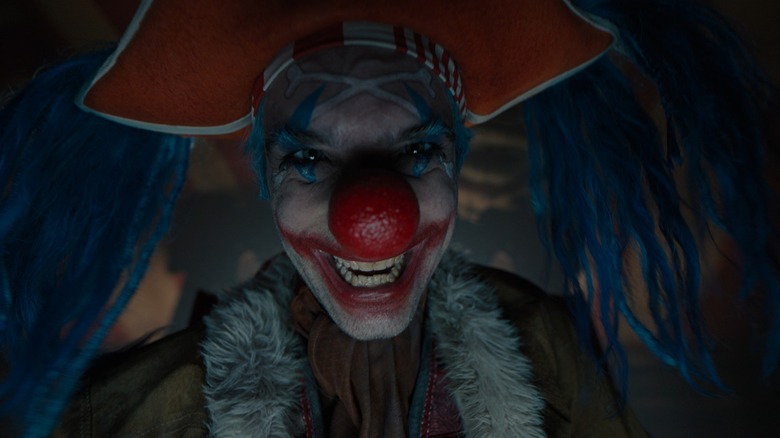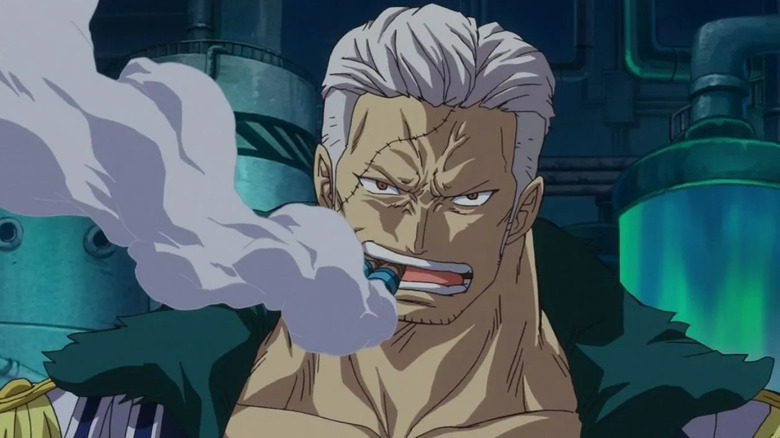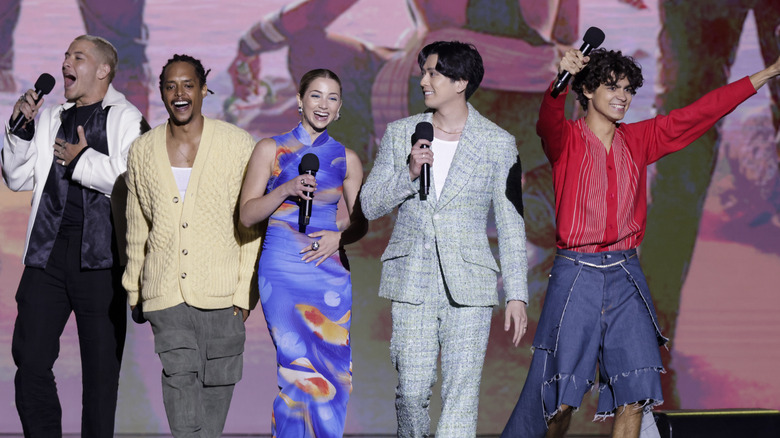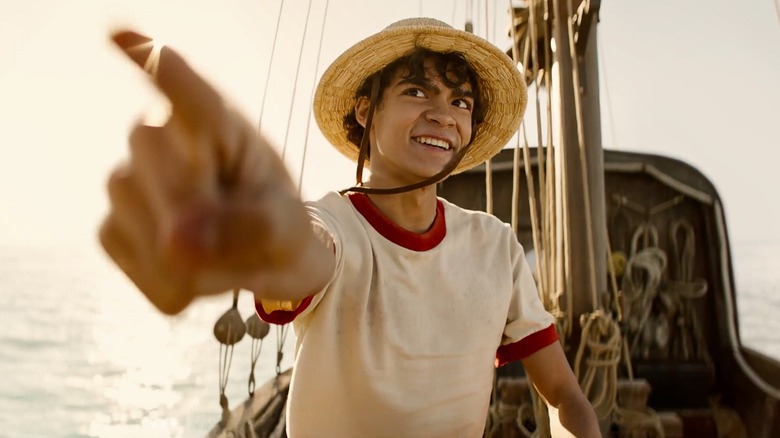The Ending Of Netflix's One Piece Season 1 Explained
Contains spoilers for Netflix's "One Piece"
With over a thousand manga chapters and anime episodes, "One Piece" can be one of the most intimidating series to start. The first season of the live-action Netflix adaptation of "One Piece" offers a more condensed telling of the pirate adventure story's first of many sagas, introducing the five main Straw Hat Pirates and concluding as they officially begin their voyage to the Grand Line. Whether the show will be successful enough to continue to adapt the rest of the story remains to be seen — even at its sped-up pace, it would need to become Netflix's longest-running original series to catch up to its source material.
Manga and anime fans have good reason to be wary of live-action adaptations, and "One Piece" Season 1 will assuage some worries (it was clearly made with love for the source material), while confirming others as well-founded (the rushed pacing blunts some of the emotions, and a lot of the wackier design work doesn't translate well to live-action on a streaming budget). Given how cancel-happy Netflix can be, it's hard to say whether the season finale is the beginning of a grand adventure or the end of something that never had a chance. Either way, we're here to explain how Season 1 of Netflix's "One Piece" concluded, and what could be in the series' future.
What you need to remember about the plot of One Piece Season 1
Season 1 of "One Piece" on Netflix adapts the manga and anime's opening East Blue Saga. The story follows Monkey D. Luffy (Iñaki Godoy), a good-natured young pirate whose body stretches like rubber due to eating a Devil Fruit. Seeking out the One Piece, the treasure of legendary pirate Gol D. Roger (Michael Dorman), Luffy assembles a crew over the course of the season, each member with their own unique abilities and goals.
The swordsman Zoro (Mackenkyu) and the navigator Nami (Emily Rudd) are the first to join him. Usopp (Jacob Romero), a teller of tall tales who's mastered using a slingshot, joins them on Syrup Island, where the crew also gets a new ship, the Going Merry. Sanji, a womanizing waiter with martial arts skills, volunteers to become the Straw Hat Pirates' chef — at the same time, Nami betrays the group, stealing their map and giving it to the fish-man Arlong (McKinley Belcher III).
When Nami was a child, Arlong murdered her adoptive mother Belle-Mere (Genna Calloway) and conquered her hometown of Coco Village. Nami has since been robbing pirates for the purpose of getting enough money to buy the village back from Arlong — a plan that is doomed to failure. Nami feels terrible about betraying her crew and stabs herself in the arm over the tattoo she was forcibly given by the Arlong Pirates. Luffy stops her, and agrees to help her defeat Arlong.
Meanwhile, Koby (Morgan Davies) and Helmeppo (Aidan Scott), Marines who crossed paths with Luffy in the first episode, are pursuing the Straw Hats while working under Vice Admiral Garp (Vincent Regan) — who turns out to be Luffy's grandfather.
Whew — we think that's everything!
What happened at the end of One Piece Season 1?
In the season finale, "WORST IN THE EAST," the Straw Hat Pirates do battle with the Arlong Pirates on behalf of the people of Coco Village. Luffy faces off against Arlong himself. Fighting inside Arlong Park's central building, the fish-man is invulnerable to the rubber boy's attacks, but Luffy realizes that he doesn't need to hurt Arlong directly — he just needs to destroy the building so it crashes down on top of him. The plan works, with Arlong defeated and Luffy unscathed.
Just as the Straw Hats are celebrating their victory with the villagers, the Marines come in to arrest them. Koby and Helmeppo challenge Garp's orders, but Garp goes ahead to challenge his grandson to a fight. This is ultimately meant as a test of Luffy's resolve, and Garp lets him go when it's clear nothing can change his mind. Garp later reveals he respects how Koby and Helmeppo stuck to their personal codes of justice and offers to train them.
One Marine, Captain Nezumi (Rory Acton Burnell), is upset that Garp doesn't actually want to arrest the Straw Hats, and puts Luffy on a wanted poster with a high bounty. Koby shows Luffy the poster, knowing he'll be overjoyed at achieving such infamy as a pirate. Nami has her tattoo replaced with a new design. Luffy brings several orange trees from Coco Village aboard the Going Merry to remind Nami of home, while Nami and the other Straw Hats gift Luffy a main sail with the group's new insignia. The Straw Hats sail off towards the Grand Line, heading first towards Reverse Island.
How compressed was the series finale?
Altogether, Season 1 of Netflix's "One Piece" compresses about 11 volumes of the manga, or 45 half-hour episodes of the anime, into eight hour-long episodes — and that's not even counting the Garp subplot, which mostly reflects content from way later in the source material. That results in a pretty packed series, and this is taken to its greatest extreme in the series finale: This one live-action episode covers around 15 chapters of the manga, or eight episodes of the anime, plus an original Garp vs. Luffy fight.
That the show is able to fit this much content into a single episode is in large part due to a very different approach to handling the fights. While making sure to accurately adapt the characters' fighting techniques, what was originally a series of individual stand-offs between different Straw Hats and fish-men gets changed into a fast-paced, cross-cutting battle that's over in 20 minutes. It's certainly a different feel for action than other versions of "One Piece," gaining speed but losing a lot of drama, and whether fans will like this approach better or worse remains to be seen. At the very least, "One Piece" can't face the "hardly anything happens in an individual episode" criticism that often applies to binge-ready streaming shows.
Does Arlong have a point?
Arlong is the type of villain where half of the time when he speaks, you think he's basically in the right (if a little misguided), and the other half of the time, you think he's the most loathsome person ever. In the world of "One Piece," fish-men have been enslaved and oppressed by humans, and Arlong seeks to liberate them — by enslaving and oppressing humans in turn. He's a similar villain archetype to Magneto or Killmonger, where his motivation is rooted in an understandable rage at injustice, but his actions in response are so evil that he loses sympathy.
In the manga and anime versions of the Arlong Park Arc, Arlong is even less sympathetic. The history of bigotry against the fish-men isn't revealed in detail until the Fish-man Island Saga much later in the series, so initially Arlong comes across as purely an anti-human bigot. Revealing his backstory earlier creates a very different impression of the character. If "One Piece" continues to adapt roughly one saga per season (which would get increasingly difficult given how long some sagas go), they won't get to Fish-man Island until Season 7. But given what's already been started, perhaps there might be opportunities to work this aspect of the world-building into the series earlier.
What was Garp's purpose this season?
The most obvious change from the manga and anime so far in the live-action "One Piece" is that Garp is introduced way earlier. Luffy's Marine grandfather is initially revealed in the manga via a run of "cover stories" (quick side-stories on the cover pages of chapters, following up on previously introduced characters) about Koby and Helmeppo, which was adapted into episodes 68 and 69 of the anime. Garp doesn't reunite with Luffy or play a role in the main storyline until the Water 7 Saga, and this reunion happens under very different circumstances than in the live-action show.
The decision to bring Garp in earlier seems to be a mix of taking inspiration from the Diary of Koby-Meppo cover stories and an intention of building more drama from the Straw Hats' interactions with the Marines. The conflict is certainly more personal having family on opposite sides of the law. Garp also becomes the season's "final boss" of sorts, fighting Luffy in a battle that can serve as a climax for the whole season, in contrast to the rest of the show's relatively self-contained two-episode arcs. If Netflix's "One Piece" doesn't make it to Season 4, at least Garp will have already made his appearance here.
How does expanding so many roles change the story?
In contrast to the manga and anime, where characters can disappear for long stretches before making their big reappearances, Netflix's "One Piece" seems to want to have as many of its supporting characters appear as often as possible. Arlong is introduced as early as episode 3 in an attempt to build him up as a villain without the luxury of being able to give him a 15-episode arc like the anime could. Koby and Helmeppo are presences throughout the season, partially due to the characters' cover stories and partially as a means to emphasize the theme of there being good people on both sides of the law.
Buggy the Clown (Jeff Ward) was the other supporting character to receive manga cover stories during the East Blue Saga, but his expanded role in the live-action adaptation is completely different from that storyline. Here, Buggy teams up with Arlong and uses Chop-Chop Fruit abilities to track down the Straw Hats. The Straw Hats then use Buggy in the same fashion to track down Nami after she leaves. In the season finale, Buggy abandons the battle with the fish-men after reattaching all his body parts together. He swears to kill Luffy after seeing his bounty poster, before fellow villain Alvida (Ilia Isorelýs Paulino) says she wants to do it herself. This could be set-up for next season to adapt the Loguetown Arc, but since Loguetown was initially Buggy's big return in the main manga/anime storyline, that will play very differently with his significantly increased role.
What the pre-credits scene means
The "One Piece" Season 1 finale does not include any mid-credits or post-credits scenes, but between the appearance of the show's logo and the start of the credits, there is a brief scene teasing Season 2. In the pre-credits scene, a man shown from behind sits at a desk holding two cigars. With one of these cigars, he burns Luffy's wanted poster. No name is listed in the credits — since the character's only shown from behind, it's likely the role has yet to be officially cast — but any "One Piece" fan can tell you this character is Smoker.
Smoker the White Hunter is a Marine who serves as both a relentless enemy and occasionally an unlikely ally to Luffy. He is first introduced in the Loguetown Arc, though it remains unclear exactly what the Netflix adaptation plans to do with that arc, given it is technically part of the East Blue Saga already adapted in Season 1. Even if the timing of his introduction is changed, however, he's sure to play a major role in future seasons should the show get renewed.
What has the cast and crew of One Piece said about the ending?
Due to the Writers Guild of America and Screen Actors Guild strikes in Summer 2023, Season 1 of the live-action "One Piece" has not had a traditional press cycle in terms of cast and writing crew discussing every detail of the show in interviews. However, Netflix sent out a packet of press notes featuring pre-strike interviews where some creatives talked vaguely about the ending.
Original manga author Eiichiro Oda alluded to the season's end point by saying, "The story will span 8 episodes and take us up through you-know-where!!" Based on what parts of the manga were announced to be adapted, fans would know that "you-know-where" refers to the Grand Line. Oda's letter in the press notes is mainly focused on emphasizing his support for the adaptation and how the show was made by fans.
Nami actress Emily Rudd didn't talk about the season finale, but when asked about the scene that made her a "One Piece" fan, she did discuss one that was adapted at the end of the season's penultimate episode, when her character finally asks Luffy for help. "She wants to do everything herself, and that moment is the first time in years, maybe ever, that she has ever asked anyone for help." She explained, going on to say, "That's when you realize they're a crew, that they're family. And that speaks to the heart of the show. It's all about love and family, supporting each other, and following your dreams. In her darkest moment, you have someone there saying, 'I got you.'"
What the end of Season 1 could mean for the series
Whether Netflix's "One Piece" will be renewed for a second season remains uncertain. Infamously, the last live-action anime adaptation from Netflix and Tomorrow Studios, "Cowboy Bebop," was canceled after just one season, despite debuting with high viewership numbers. Whereas "Cowboy Bebop" creator Shinichiro Watanabe was completely hands-off and ultimately disappointed with the adaptation, the live-action "One Piece" has had the full support of and significant involvement from Eiichiro Oda, and fans might respond better to this more faithful adaptation. However, it still has significant artistic and pacing problems, with a lot of moments that show just how much better this material is suited to illustrated mediums. There's no guarantee the live-action version will be a hit.
Should there be a second season, it might adapt the events of the Loguetown Arc in some form, and it will definitely adapt at least the beginning of the Arabasta Saga. This section of the story introduces multiple new characters, including the members of the Baroque Works syndicate (including future Straw Hat Nico Robin) and the reindeer doctor Chopper. Handling Chopper in live-action might be the biggest challenge the adaptation faces yet: Do him right and you have the next Baby Yoda, do him wrong and you have nightmare fuel.
